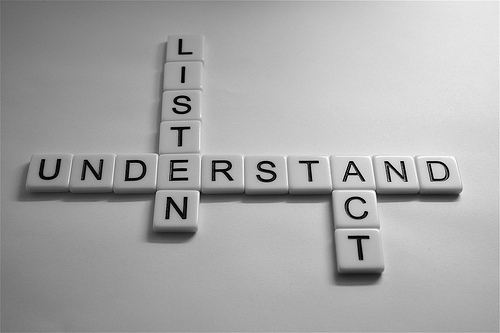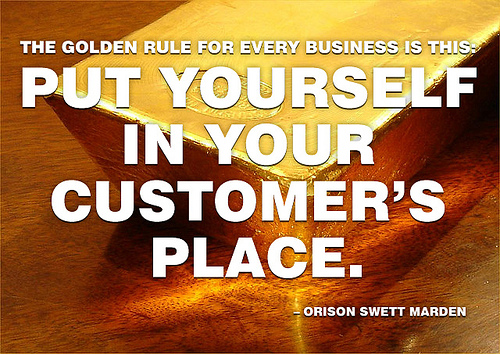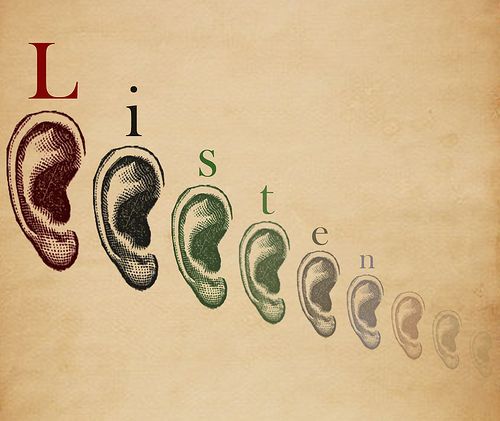Are you a community manager? Do you work with other people in any capacity? Then you’d better be damn good at listening! Trouble will follow if you’re not.
Believe it or not, there’s a lot more to listening than hearing someone else’s voice. Go active or go home! If you’re not actively listening, then you’re not truly listening. Communication won’t work unless both parties get the chance to convey their points of view.
Before I launch into the 5 steps to active listening skills and heightened empathy, here’s a quick breakdown of what the term means.
The four rules of active listening are:
1. Seek to understand before you seek to be understood.
2. Be non-judgmental.
3. Give your undivided attention to the speaker.
4. Use silence effectively.Source: U.S. Department of State

Thinking about the type of wine you’ll drink with dinner? YOU’RE LISTENING WRONG.
Sounds easy enough, right? Maybe. But active listening is easier to understand than it is to actually implement. That’s where the 5 empathy-building steps come in!
(It looks like a lot more than 5, I know. But I felt the need to break down each one even further so you’ll know exactly what to do).
1. Bite your tongue and focus on what the other person says.
Be quiet while the other party speaks. Don’t interject with commentary or retorts until they’ve finished saying what they need to say. How can you truly listen if your mind is already forming what you’ll say next?
That means you SHOULD NOT:
- Form your retort in your head instead of listening.
- Jump ahead with what you want to say before the other person’s finished talking.
- Let anger provoke you into saying something you’ll regret.
- Allow distractions to take focus away from the conversation.
Instead, you SHOULD:
- Focus on and absorb the other person’s concerns. Write them down if you have to.
- Only speak when it’s appropriate (for example, to tell them you understand).

See that? Be like this goat.
2. Be conscientious, not condescending.
Acknowledge that you’ve heard what they’ve said, but don’t adapt a holier-than-thou attitude when you respond. An angry customer won’t like being talked down to any more than you would.
Do NOT:
- Ask too many “why” questions; they could come off as rude.
- Patronize or belittle the other person with terms like, “I know just how that feels.” Chances are, you don’t.
- Misplace the blame. Even if you’re not directly responsible, blaming someone else isn’t going to fix anything. It’ll only further compromise the trust level.
DO:
- Offer validation that you’ve heard their side of the story (such as “I understand. Thank you for letting me know about this.”).
- Provide meaningful feedback instead of criticism. Now is your time to speak up and offer a beneficial solution.
- Encourage them to elaborate if clarification is needed. There’s nothing wrong with asking a few appropriate questions as long as you’re not making them repeat the story all over again!

Listen, Understand, and Act. In that order.
3. Keep the topic focused to better resolve issues.
We’ve all encountered tricky situations where tempers escalate or miscommunication abounds. The trick? Focus! This type of focus is slightly different than the #1 step, because you’ll have to do more than just listen. If you do only one thing, make sure it’s keeping a cool head even if anger comes into play.
DON’T:
- Change the subject if the main issue hasn’t been addressed.
- Allow yourself to get tangled into arguments. Arguments won’t help solve problems.
- Bombard your customer with too many questions. No one likes to be interrogated.
DO:
- Direct the conversation to a positive end result.
- Maintain a friendly demeanor. People typically find it more difficult to yell at a calm person than an equally irate one.
- Alleviate the other party’s stress levels through verbal acknowledgement (or non-verbal if you’re in the same room).

Concentrate. You can do it.
4. Remember the Golden Rule.
What’s the Golden Rule? Treat others as you’d like to be treated. Not exactly a brand spankin’ new concept, but it applies in nearly every facet of our lives (especially customer service).
Make sure you ARE:
- Patient
- Understanding
- Calm
- Helpful
And make sure you are NOT:
- Agitated
- Distracted
- Angry
- Rude

Exactly!
5. Practice listening with a friend or family member.
It sounds silly but it works. Arrange a conversation with someone you’re comfortable with, whether face to face or on the phone, and discuss a topic where opinions have room to flow. Practice your focus, try to implement verbal and non-verbal acknowledgement, provide helpful feedback, and remain calm even if the discussion heats up. Listening won’t be a national sport anytime soon, but that doesn’t mean you can’t practice it and sharpen your customer service skills!

This is how you should appear when you’re actively listening, only 75% less cute.
Through the use of these steps, you should be on the track to become an active listening pro! Remember, evil is the absence of empathy, so it never hurts to improve your game.
How do you practice active listening? Do you agree that it’s an important part of community management? Which part do you struggle with the most?
Image cred: ky_olsen, madabandon, teamstickergiant, World of Oddy, highersights, and 2-dog-farm
Sources: Beyond Intractability and Psych Central
Jill composes all kinds of content for QualityLogoProducts.com, including site product descriptions and articles for their branding inspiration blog. She also helps with social media efforts. She's a bit of a chatterbox when she gets to know you, so speak up anytime to start a conversation!


Listening is SO hard. SO hard.
In my humble opinion I think the popularity of social networking has made us all WORSE listeners. It’s training us to be passive participants at best. It’s also a broadcasting medium, and when you’re busy shouting, you’re not practicing good listening.
Being ALWAYS connected to the internet doesn’t help either. I can’t remember the last time I watched a movie or TV show with my smartphone or tablet near buy. I catch myself constantly checking my email during commercials or breaks in action.
I think our ears and listening is out least used sense!